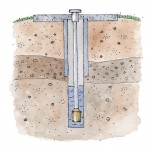From deep underground to deep trouble
August 1, 2016 Can you name the next big thing in the mining industry?
Can you name the next big thing in the mining industry?
A newfound vein of gold or silver, perhaps? Rare earths that are used in cell phones? Previously untapped supplies of coal?
Nope. It’s water.
In India and other countries all over the globe, people have given up traditional farming and instead are selling water mined from aquifers deep underground, according to a story from National Geographic. A man from India told the writer, “”I no longer grow crops, I farm water. The tankers come about ten times a day. I don’t have to do anything except keep my reservoir full.”
In order to keep those reservoirs full, the story states, he drilled holes deep into the ground and hooked up pumps that run all day and all night to bring the water up. Each tanker that’s filled up nets him about $4.
The story goes on to quote an estimate from the journal Water Resources Research: “India alone is pumping out some 46 cubic miles of water a year from below ground, while nature is refilling only 29 cubic miles, a shortfall of 17 cubic miles (70 cubic kilometers) per year. A cubic kilometer is 264.2 billion gallons, or about enough water to fill 400,000 Olympic-size swimming pools.”
In some places around the world, the story says, “water that you could once bring to the surface with a bucket on a short rope is now a mile or more down.”
It’s also happening right here in the U.S.: The story says we pump about 7.2 cubic miles of water from deep underground aquifers each year.
There are many materials mined from the earth, but water is the one thing we cannot live without. If we continue to use up water at this rate, a global crisis looms.
And it’s not just water use that’s threatening our global supplies: A report from the Pacific Institute warns that “Every day, 2 million tons of sewage and industrial and agricultural waste are discharged into the world’s water, the equivalent of the weight of the entire human population of 6.8 billion people. … The UN estimates that the amount of wastewater produced annually is about 1,500 km3 , six times more water than exists in all the rivers of the world.”
Just look at one of the latest stories about the water our Olympic swimmers will be exposed to in Brazil. Tests have shown that people ingesting just 3 teaspoons of it are “almost certain to be infected with viruses that can cause stomach and respiratory illnesses and, more rarely, heart and brain inflammation.”
This is serious stuff. Preserving our water supplies and keeping them clean are problems we all need to work together to solve.
We can’t take clean water for granted anymore.